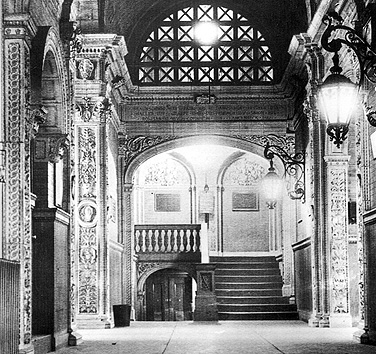Flashback
150 years ago
UB’s first medical buildings

The first building in Buffalo built specifically and solely for collegiate education was constructed in 1849 and located on the corner of Main and Virginia streets. It was the second home of the University of Buffalo School of Medicine following the leasing of the First Baptist Church at Seneca and Washington streets, where medical lectures were first hosted beginning in 1846. The new medical building, adjacent to Sisters of Charity Hospital, was built at a cost of $15,000 and was recognized at the time as the most advantageous and ergonomic medical school facility in the nation.
At the building’s dedication, Austin Flint, one of the three founders of the medical school, described special features of the lecture rooms:
Cast-iron chairs, with bottoms firmly screwed on cushioned benches…[combine] all the advantages of a luxurious armchair. The right arm of each chair is expanded for the purpose of taking notes…If the faculties of the mind are inactive, it will not be because the attention is absorbed by uneasy sensations of the body…the indulgence of postures favorable to indolence and sleep is effectively prevented.
The third home of UB’s medical school, pictured here, opened in 1893 at Main and High streets. Built by architect George Cary in the Italian Renaissance style, it was a “medical palazzo.” Cary also was the architect for the Buffalo and Erie County Historical Society and for the signature gates and administration building of Forest Lawn Cemetery. The 12,000-square-foot building at 24 High St. was praised for its perfect balance between “utility and convenience” and its architectural symmetry. It was finished “entirely with terracotta, pressed brick, iron and hard wood.” The dissecting room was more than 90 feet long with an asphalt floor. The architect explained:
It was partly for the sake of this educating influence, as well as for economy, strength, safety and cleanliness, that the open system of internal construction was adopted, which avoids all concealed spaces and exposes every plank and timber and every pipe to view—so that a walk through the building may be said to be a lesson in anatomy.
The building included lecture rooms that were named for such figures as Hippocrates, Lister and Pasteur; a dispensary; faculty offices; several laboratories; and a fireproof space for the medical library. Following the establishment of UB’s main campus at Main and Bailey in 1953, the High Street building was razed in 1954. The two bronze plaques visible in the accompanying photo at the top of the short stairway were preserved and eventually placed in Farber Hall in 1977.
—Judith Adams-Volpe, University Libraries

Reader Comments